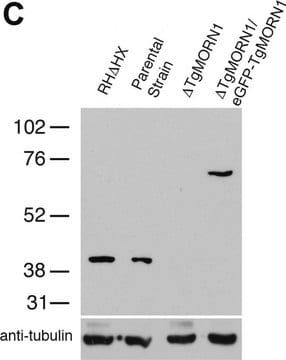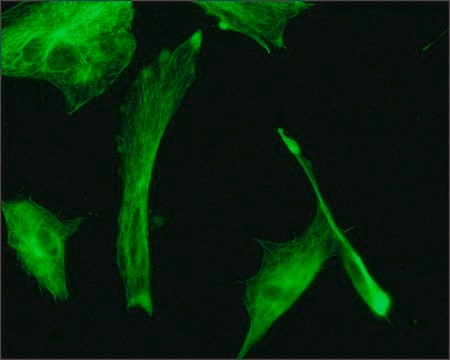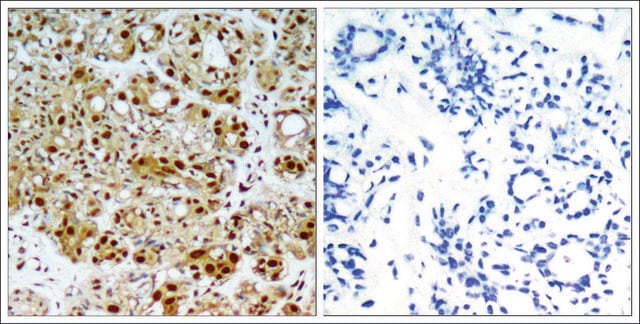Clone AA2 is a mouse monoclonal antibody that detects β-Tubulin. The epitope has been mapped to amino acids 412-430.
Kluczowe dokumenty
T8328
Anti-β-Tubulin antibody, Mouse monoclonal
~2.0 mg/mL, clone AA2, purified from hybridoma cell culture
Synonim(y):
Beta Tubulin Antibody Sigma, Beta Tubulin Antibody Sigma - Monoclonal Anti-β-Tubulin antibody produced in mouse, Anti-TUBB, Anti-Tubulin, beta
Wybierz wielkość
913,00 zł
Wybierz wielkość
About This Item
913,00 zł
Polecane produkty
pochodzenie biologiczne
mouse
Poziom jakości
białko sprzężone
unconjugated
forma przeciwciała
purified from hybridoma cell culture
rodzaj przeciwciała
primary antibodies
klon
AA2, monoclonal
Formularz
buffered aqueous solution
masa cząsteczkowa
antigen ~50 kDa
reaktywność gatunkowa
human, mouse, rat, bovine
opakowanie
antibody small pack of 25 μL
stężenie
~2.0 mg/mL
metody
immunocytochemistry: suitable
immunohistochemistry: suitable
immunoprecipitation (IP): suitable
western blot: 1-2 μg/mL using Neuro-2a cell extract
izotyp
IgG1
numer dostępu UniProt
Warunki transportu
dry ice
temp. przechowywania
−20°C
docelowa modyfikacja potranslacyjna
unmodified
informacje o genach
human ... TUBB(203068)
Opis ogólny
Specyficzność
Immunogen
Zastosowanie
Działania biochem./fizjol.
B2702 peptide binds to β-tubulin and inhibits natural killer (NK) cell cytotoxicity and it influences microtubule polymerization, which damages cytoskeleton organization and chaperone-like activity of tubulin. Mutation in the gene leads to various neuronal migration disorders such as lissencephaly, pachygyria and polymicrogyria malformations.
Postać fizyczna
Przechowywanie i stabilność
For extended storage, freeze at -20 °C in working aliquots. Repeated freezing and thawing, or storage in “frost-free” freezers, is not recommended. If slight turbidity occurs upon prolonged storage, clarify the solution by centrifugation before use. Working dilution samples should be discarded if not used within 12 hours.
Oświadczenie o zrzeczeniu się odpowiedzialności
Nie możesz znaleźć właściwego produktu?
Wypróbuj nasz Narzędzie selektora produktów.
polecane
Kod klasy składowania
10 - Combustible liquids
Temperatura zapłonu (°F)
Not applicable
Temperatura zapłonu (°C)
Not applicable
Środki ochrony indywidualnej
Eyeshields, Gloves, multi-purpose combination respirator cartridge (US)
Wybierz jedną z najnowszych wersji:
Certyfikaty analizy (CoA)
Nie widzisz odpowiedniej wersji?
Jeśli potrzebujesz konkretnej wersji, możesz wyszukać konkretny certyfikat według numeru partii lub serii.
Masz już ten produkt?
Dokumenty związane z niedawno zakupionymi produktami zostały zamieszczone w Bibliotece dokumentów.
Klienci oglądali również te produkty
Produkty
Frequently asked questions about neural stem cells including NSC derivation, expansion and differentiation.
-
We used your anti-beta-tubulin monoclonal antibody (cat# T8328) and obtained an interesting change not seen with another antibody. Would this antibody (T8328) have been raised to a particular site that undergoes modification? Any publications on it?
1 answer-
Helpful?
-
Active Filters
Nasz zespół naukowców ma doświadczenie we wszystkich obszarach badań, w tym w naukach przyrodniczych, materiałoznawstwie, syntezie chemicznej, chromatografii, analityce i wielu innych dziedzinach.
Skontaktuj się z zespołem ds. pomocy technicznej













